Chapter 17.191
SIGNS
Sections:
17.191.000 Sign regulations.
17.191.010 Definitions.
17.191.020 Design, construction, and maintenance.
17.191.030 Enforcement.
17.191.040 Signs generally permitted.
17.191.050 Prohibited signs.
17.191.060 Signs permitted in residential zones.
17.191.065 Signs in public, farm and forest zones.
17.191.068 Signs for the Aurora Airport business center in a public zone.
17.191.070 Signs for integrated business centers in an interchange district zone.
17.191.080 Signs in other zones.
17.191.090 Signs within special street setbacks.
17.191.100 Illumination.
17.191.110 Electronic display sign standards.
17.191.120 Variance.
17.191.000 Sign regulations.
The sign regulations in this chapter are intended to provide minimum standards to safeguard property and public welfare, to preserve locally recognized values of community appearance, and to reduce hazards to motorists and pedestrians traveling on public streets. A sign is considered a use of property under the provisions of this code. [Ord. 1296 § 4(1) (Exh. A), 2009; Ord. 1204 § 4, 2004; Ord. 1096 § 4, 1998; Ord. 516 § 2, 1978. RZ Ord. § 191.000.]
17.191.010 Definitions.
For the purpose of this chapter the following definitions shall apply:
A. “Alteration” means any change in the size, shape, method of illumination, position, location, material, construction, or supporting structure of a sign.
B. “Aurora Airport business center” identifies the area at the Aurora State Airport and surrounding public zone.
C. “Awning” means a temporary or removable shelter supported entirely from the exterior of a building and composed of nonrigid materials except for support framework.
D. “Awning sign” means a sign painted on or affixed to an awning.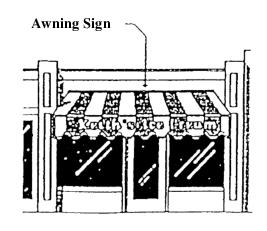
E. “Building face or wall” means all window and wall area of a building on one plane or architectural elevation.
F. “Building frontage” means the portion of a building facing a street right-of-way or on-site parking lot.
G. “Change of sign face” means where an existing sign is altered by a change of message or design on the sign face, without any change to the size or shape of the sign framework or structure, excluding marquee, electronic message boards, menu boards, and changeable face signs.
H. “Display” means any identifiable visual form or character, which may be comprised solely or be comprised of a combination of words, symbols, images, and graphic elements.
I. “Electronic display sign” means a sign including, or comprised solely or partially of, an electronic display that can be changed by automatic means, including, but not limited to, the operation of computer software, is internally illuminated, is permanently fixed to a foundation and shall not include TPCMS (temporary portable changeable message signs).
J. “Effect” means sequential, flashing, or simultaneous illumination by electrical means other than by an electronic display. As used in this chapter, effects include, but are not limited to:
1. Animated effect: illumination that depicts a moving object, thing, person, animal, or happening or depicts an ongoing series of images.
2. Chaser effect: illumination that is intended to lead the eye by producing lineal or circular movement.
3. Scintillating effect: illumination that provides a random twinkling of lights, including illumination that forms images, words or sentences at the end of the sequence of twinkling lights.
4. Speller effect: illumination that spells a word, one letter, sentence, number, or character at a time, including flashing a complete word or words or sentence.
K. “Electronic time and temperature sign” means a sign, or portion thereof, that announces time, temperature and/or date.
L. “Electronic display” means a display created by light emitting diodes, liquid crystal displays, plasma display panels, pixel or sub-pixel technology, or other similar technology. As used in this chapter, electronic displays include, but are not limited to:
1. Dissolve: the changing of an electronic display by means of varying light intensity or pattern, where one display gradually appears to dissipate or lose legibility simultaneously with the gradual appearance and legibility of a subsequent display.
2. Fade: the changing of an electronic display by means of varying light intensity, where one display gradually reduces intensity to the point of being illegible or imperceptible and the subsequent display gradually increases intensity to the point of being legible or capable of being perceived.
3. Scrolling: the changing of an electronic display by the apparent vertical movement of the visual image, such that a new visual image appears to ascend and descend, or appear and disappear from the margins of the sign in a continuous or unfurling movement.
4. Static display: an electronic display that does not change.
5. Travel: the changing of an electronic display by the apparent horizontal movement of the visual image.
6. Video display: providing an electronic display in horizontal or vertical formats to create continuously moving images.
M. “Fabric sign” means any sign, banner, pennant, valance or advertising display constructed of cloth, canvas, fabric or other light material, with or without frames, which is not permanently affixed to a supporting structure.
N. “Flashing” means sudden or intermittent electrical illumination.
O. “Freestanding sign” means a sign supported by one or more upright poles or braces placed in or upon the ground and wholly detached from any building. Also known as a ground sign.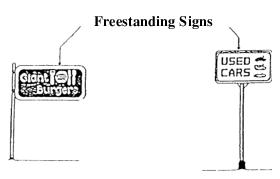
P. “Indirect illumination” means a source of illumination directed toward a sign so that the beam of light falls upon the exterior surface of the sign.
Q. “Integrated business center” means a group of two or more businesses and/or uses which have been developed as a unit and which have common parking facilities.
R. “Internal illumination” means a source of illumination from within a sign, including neon signs, but not including electronic message board signs and temporary portable changeable message signs.
S. “Marquee” means a permanent roofed structure, but not an enclosed structure, attached to or supported by a building for the purpose of providing shelter to patrons.
T. “Nit” means a measurement of luminance, where one nit is equal to one candela per square meter (1cd/m2). A “candela” means a unit of measurement of the intensity of light, where one candela is the monochromatic radiation of 540THz with a radiant intensity of 1/683 watt per steradian in the same direction. By way of example, an ordinary wax candle generates approximately one candela.
U. “Nonconforming sign” means an existing sign, lawful at the time of the enactment of this chapter, which does not conform to the requirements of this code.
V. “Portable sign” means any sign not permanently attached to the ground, a building, or other structure, not including TPCMS (temporary portable changeable message signs).
W. “Projecting sign” means signs other than wall signs, which are attached to and project from a structure or building face more than 18 inches.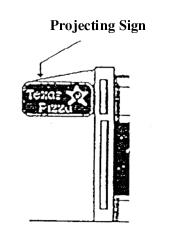
X. “Roof sign” means a sign supported by, and located on or over, the roof of a building.
Y. “Sign” means any medium, including its structure and component parts, which is used or intended to be used to attract attention to the subject matter for advertising or identifying purposes. “Sign” does not include any cloth attached to a single pole equipped to raise and lower the cloth from the ground.
Z. Sign Area.
1. Except as provided in subsection (Z)(2) of this section, the area of a sign shall be calculated by adding the outer dimensions of all the faces presenting a sign message. Pole covers and columns shall not be included in the area of the measurement if they do not include advertising. Double-faced signs will be calculated as one sign only when placed back-to-back and separated by no more than 24 inches.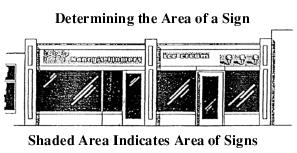
2. The area of a wall sign without a border shall be computed by enclosing the entire sign within sets of parallel lines touching the outer limits of the sign message.
AA. “Sign height” means the distance measured from the average elevation of the ground adjacent to the structure that the sign is mounted on, or the elevation of a public sidewalk or street curb within 10 feet of the sign structure, to the greatest height of the sign face.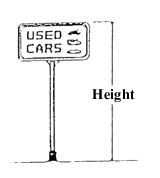
BB. “Sign structure” means the supports, uprights, braces, framework and other structural components of the sign.
CC. “Street frontage” means the portion of a property which abuts a street right-of-way.
DD. “Temporary portable changeable message signs (TPCMS)” means any sign that is visible for only 60 days twice per year capable of displaying words, symbols, figures or images that can be electronically or mechanically changed by remote or automatic means with a dwell time of six seconds, is internally illuminated, not permanently affixed to the ground, a building, or other structure, serves a temporary purpose, is freestanding without a permanent foundation, and contains a surface area of no more than 32 square feet and a height of no more than eight feet.
EE. “Temporary sign” means any sign that is visible for only 60 days twice per year, is without illumination, not permanently affixed to the ground, a building, or other structure, serves a temporary purpose, is freestanding without a permanent foundation, including lawn signs, vehicle signs, fabric signs and balloon signs but not including TPCMS (temporary portable changeable message signs).
FF. “Under marquee sign” means a sign which is erected or maintained under and is supported by a marquee.
GG. “Wall sign” means any sign placed or painted directly against a building wall, with the exposed face of the sign in a plane approximately parallel to the plane of the wall and projecting outward from the wall not more than 18 inches.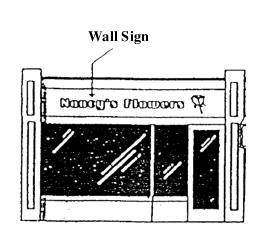
HH. “Window sign” means any sign that is erected or placed within a building or structure but is visible from the exterior of said building or structure. [Ord. 1326 § 4 (Exh. A), 2012; Ord. 1296 § 4(1) (Exh. A), 2009; Ord. 1204 § 4, 2004; Ord. 1096 § 4, 1998; Ord. 516 § 2, 1978. RZ Ord. § 191.010.]
17.191.020 Design, construction, and maintenance.
All signs shall be designed, constructed, altered, and maintained according to the following standards:
A. All signs shall comply with the applicable provisions of the Oregon Structural Specialty Code and all other applicable county structural, electrical and other regulations.
B. Except for banners, flags, temporary signs and window signs conforming in all respects with the requirements of these regulations, all signs shall be constructed of permanent materials and shall be permanently attached to the ground, a building, or other structure.
C. All signs shall be maintained in good structural condition.
D. The owner of the property on which the sign is located shall be responsible for its erection and maintenance and its compliance with the provisions of these regulations or other laws or ordinances regulating signs. [Ord. 1296 § 4(1) (Exh. A), 2009; Ord. 1204 § 4, 2004; Ord. 1096 § 4, 1998; Ord. 516 § 2, 1978. RZ Ord. § 191.020.]
17.191.030 Enforcement.
The planning director may determine a sign to be unlawful or abandoned and require its removal or alteration to conform with this chapter and other applicable county law if it endangers public safety or violates the provisions of this chapter. [Ord. 1296 § 4(1) (Exh. A), 2009; Ord. 1204 § 4, 2004; Ord. 1096 § 4, 1998; Ord. 516 § 2, 1978. RZ Ord. § 191.030.]
17.191.040 Signs generally permitted.
Subject to the limitations in MCC 17.191.050, 17.191.060, 17.191.065, 17.191.070, and 17.191.080, the following signs and sign work are permitted in all zones. Except for signs described in subsection (A) of this section, the following signs shall not be included when determining compliance with total allowed area:
A. Change of Sign Face. Altering the message or design on the sign face, without any change to size or shape of the sign framework or structure.
B. Traffic Control Devices, Roadway Signs, Required Public Notices. Traffic signs and all other signs erected or maintained by a municipal or governmental body or agency, including danger signs, railroad crossing signs, city entrance signs, and signs of a noncommercial nature required by public laws, ordinances or statutes. Notices and signs erected by public officers performing official duties including those erected pursuant to law, administrative order, or court order.
C. Other Warning Signs. Signs placed on private property to warn the public of a danger or prohibition located on the private property, including, but not limited to, “No Trespassing” or “No Dumping” signs, provided such sign does not exceed four square feet in area and six feet in height.
D. Building Identification. Permanent building plaques, corner stones, name plates and similar building identifications not more than four square feet in area per building.
E. Historical Signs. Markers erected or maintained by a recognized historical society or organization identifying sites, buildings, or structures.
F. Interior Signs. Signs located in the interior of any building or within an enclosed lobby or court of any group of buildings, which are designed and located to be viewed by patrons.
G. Real Estate Signs. While a lot, building, or portion of a building is for rent, sale or lease, one unlighted sign visible from each street frontage is permitted. Each sign shall not exceed 12 square feet in a residential zone.
H. Preexisting Nonconforming Signs. Permanent signs that existed and were legal prior to the date of adoption of the ordinance codified in this chapter that do not conform to the provisions of this chapter with respect to number, surface area, location, or illumination. Preexisting nonconforming signs may be repaired but not replaced unless they were approved by a previous land use decision. Replacement of signs approved by a previous land use decision may only be replaced to the same extent as was allowed in that previous decision. [Ord. 1296 § 4(1) (Exh. A), 2009; Ord. 1204 § 4, 2004; Ord. 1096 § 4, 1998; Ord. 516 § 2, 1978. RZ Ord. § 191.040.]
17.191.050 Prohibited signs.
The following signs are prohibited in all zones:
A. Vehicle Signs. Signs which are placed on or affixed to a bus, car, boat, trailer or other motorized vehicle and parked on public or private property with the primary purpose of providing a sign not otherwise permitted by this chapter. This provision is not intended to prohibit signs painted upon or applied directly to a vehicle that is actively used in the daily function of a business.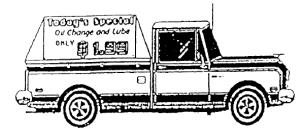
B. Hazardous Signs. No sign shall be permitted at or near the intersection of a street or driveway in such a manner as to obstruct free and clear vision of motor vehicle operators or at any location where by reason of its position, shape, or color it may interfere with or be confused with an authorized traffic sign, signal, or device, or which makes use of a word, symbol, phrase, shape or color in such a manner as to interfere with, mislead, or confuse traffic.
Illustration of hazardous signs: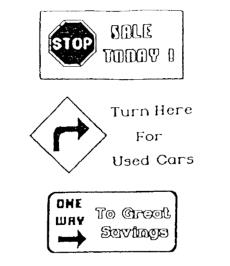
C. Animated Signs. Any sign using an effect not otherwise permitted by this chapter.
D. Balloons or similar types of anchored objects not otherwise allowed in this chapter.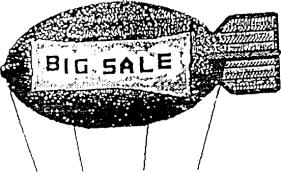
E. Portable, fabric, or temporary signs not otherwise allowed in this chapter.
F. Signs that emit audible sound, odor, or visible matter. This does not include signs integral to an intercom system serving customers remaining in their vehicles.
G. Signs that use or employ side guy lines of any type.
H. Signs that obstruct any fire escape, required exit, window or door opening used as a means of egress.
I. Signs closer than 10 feet horizontally or vertically from any overhead power line or electrical conductors.
J. Signs that project into or over driveways, roadways and street rights-of-way, except under marquee signs that project over a public sidewalk. Such under marquee signs shall not be less than seven feet six inches above the sidewalk and shall not exceed a maximum of six square feet.
K. Signs in a street right-of-way not otherwise allowed in this chapter whether attached to a pole, post, utility pole or placed on its own stake and placed into the ground. [Ord. 1296 § 4(1) (Exh. A), 2009; Ord. 1204 § 4, 2004; Ord. 1096 § 4, 1998; Ord. 516 § 2, 1978. RZ Ord. § 191.050.]
17.191.060 Signs permitted in residential zones.
Except as provided in MCC 17.191.040, no sign shall be erected or maintained in residential zones except as set forth in this section:
A. Maximum Square Footage.
1. RS Zone.
a. For single-family, duplex, or home occupations, one unlighted wall or window sign not exceeding four square feet.
b. For uses other than those in subsection (A)(1)(a) of this section, one freestanding internally illuminated or electronic display sign not exceeding 32 square feet with a dwell time of one hour, except changes to correct hour-and-minute or temperature information, which may change no more often than once every three seconds.
c. One temporary sign not exceeding six square feet and 30 inches above grade visible for 60 days twice per year.
d. One temporary sign up to 32 square feet may be approved as a variance as provided in MCC 17.191.120.
2. AR Zone.
a. For single-family, or home occupations, one unlighted wall, window or freestanding sign not exceeding 32 square feet.
b. For uses other than those in subsection (A)(2)(a) of this section, one internally or indirectly illuminated freestanding sign or one electronic display sign not exceeding 32 square feet with a dwell time of one hour, except changes to correct hour-and-minute or temperature information, which may change no more often than once every three seconds.
c. One temporary sign not exceeding 32 square feet visible for 60 days twice per year.
3. RM Zone.
a. For single-family, duplex, or home occupations, one unlighted wall, window or freestanding sign not exceeding 32 square feet.
b. For uses other than those in subsection (A)(3)(a) of this section, one internally or indirectly illuminated freestanding sign or one electronic display sign not exceeding 32 square feet with a dwell time of one hour, except changes to correct hour-and-minute or temperature information, which may change no more often than once every three seconds.
c. One temporary sign not exceeding six square feet and 30 inches above grade visible for 60 days twice per year.
d. For apartments and retirement homes, only one temporary banner sign not exceeding 50 square feet per street frontage, located on that frontage, and visible for 30 days four times per year.
B. Height Limitations. Signs shall comply with the following maximum height limitations:
1. Freestanding sign: six feet.
2. Wall and window signs: eight feet.
3. For signs allowed in subsections (A)(1)(b), (A)(2)(b) and (A)(3)(b) of this section: 15 feet.
C. Setbacks. Unless specified otherwise, signs shall comply with the following minimum setback requirements: signs shall be located at least three feet from a lot line abutting a street. All signs shall comply with requirements for vision clearance areas and special street setbacks. Freestanding signs may be erected in special setback areas. (See MCC 17.191.090.)
D. Illumination.
1. Indirect illumination shall be directed away from and not be reflected upon adjacent premises, streets or roadways. Illumination shall be subject to the standards in MCC 17.191.100(A).
2. The light source for an internally illuminated sign may be comprised of light emitting diodes, so long as the light emitting diodes are used for illumination only, do not create an electronic display or effect, and conform to the brightness limitations set forth in MCC 17.191.100(B). [Ord. 1369 § 4 (Exh. B), 2016; Ord. 1313 § 4 (Exh. A), 2011; Ord. 1296 § 4(1) (Exh. A), 2009; Ord. 1204 § 4, 2004; Ord. 1096 § 4, 1998; Ord. 516 § 2, 1978. RZ Ord. § 191.060.]
17.191.065 Signs in public, farm and forest zones.
Except as provided in MCC 17.191.040, no sign shall be erected or maintained in public, farm and forest zones except as set forth in this section:
A. One unlighted wall, window or freestanding sign not exceeding 32 square feet per street frontage.
B. One temporary sign not exceeding 32 square feet visible for 60 days twice per year.
C. One temporary portable changeable message sign for 60 days twice per year.
D. On property developed for religious organizations, museums, educational institutions and schools as defined in MCC 17.110.505 and 17.110.510, and subject to the standards above, one electronic display sign not exceeding 32 square feet with a dwell time of one hour, except changes to correct hour-and-minute or temperature information, which may change no more often than once every three seconds.
E. Height Limitations. Signs shall comply with the following maximum height limitations:
1. Freestanding sign: eight feet.
2. Wall and window signs: eight feet.
3. For signs allowed in subsection (D) of this section: 15 feet.
F. Setbacks. Unless specified otherwise, signs shall comply with the following minimum setback requirements: Signs shall be located at least three feet from a lot line abutting a street. All signs shall comply with requirements for vision clearance areas and special street setbacks. Freestanding signs may be erected in special setback areas. (See MCC 17.191.090.)
G. Illumination.
1. Indirect illumination shall be directed away from and not be reflected upon adjacent premises, streets or roadways. Illumination shall be subject to the standards in MCC 17.191.100(A).
2. The light source for an internally illuminated sign may be comprised of light emitting diodes, so long as the light emitting diodes are used for illumination only, do not create an electronic display or effect, and conform to the brightness limitations set forth in MCC 17.191.100(B).
H. Signs no larger than 800 square feet shall be permitted within stadiums, athletic fields, and other outdoor assembly facilities, where they are intended primarily for viewing by persons within the facility, are oriented toward the interior of the facility and viewing stands, and are only used during events where the public attends as spectators. Notwithstanding any other provision of this chapter, signs allowed by this subsection may employ any effect and shall not be subject to the limitation imposed in MCC 17.191.100(B). [Ord. 1369 § 4 (Exh. B), 2016; Ord. 1326 § 4 (Exh. A), 2012; Ord. 1296 § 4(1) (Exh. A), 2009.]
17.191.068 Signs for the Aurora Airport business center in a public zone.
Except as provided in MCC 17.191.040, only signs permitted in this section are allowed in an Aurora Airport integrated business center in a P zone:
A. Aurora Airport Business Center Sign. One freestanding sign structure at each driveway entrance designed to be read from the roadway.
1. Maximum height: 30 feet.
2. Maximum square footage: Total sign area shall not exceed 500 square feet.
3. Minimum Setback. Signs shall not project into the public right-of-way. Signs shall comply with requirements for vision clearance areas and special street setbacks. Freestanding signs may be placed in special setbacks (see MCC 17.191.090).
4. Illumination.
a. Indirect illumination shall be directed away from and not be reflected upon adjacent premises, streets or roadways. Illumination shall be subject to the standards in MCC 17.191.100(A) and Federal Aviation Administration (FAA) standards for lighting at airports.
b. The light source for an internally illuminated sign may be comprised of light emitting diodes, so long as the light emitting diodes are used for illumination only, do not create an electronic display or effect, and conform to the brightness limitations set forth in MCC 17.191.100(B) and Federal Aviation Administration standards for lighting at airports.
B. Signs for Individual Businesses in the Aurora Airport Business Center. Wall, awning and window signs are permitted subject to the following requirements:
1. Maximum Square Footage. The total sign area is based upon street frontage and frontage on common parking areas. The aggregate sign area shall not exceed one square foot for each linear foot of building frontage for a maximum of two building frontages. A sign shall not exceed 100 square feet.
2. Maximum height: 30 feet.
3. Illumination. Wall signs shall be internally illuminated. Illumination shall be subject to the standards in MCC 17.191.100 and Federal Aviation Administration standards for lighting at airports.
4. Parking Lot Signs. Two permanent signs to identify each motor vehicle entrance into or exit from the premises. Each sign shall be limited to eight square feet in area and a height of 30 inches above the sidewalk or 36 inches above the street elevation where there is no sidewalk.
5. On every structure with a vertical surface visible from the runway, in addition to other signage allowed under this subsection, one sign not to exceed 300 square feet on a wall, window or awning.
C. One temporary sign not exceeding 32 square feet visible for 60 days twice per year.
D. Setbacks. Unless specified otherwise, signs shall comply with the following minimum setback requirements: Signs shall be located at least three feet from a lot line abutting a street. All signs shall comply with requirements for vision clearance areas and special street setbacks. Freestanding signs may be erected in special setback areas (see MCC 17.191.090).
E. Prohibited Signs. Signs containing electronic time and temperature or electronic displays and temporary portable changeable message signs are prohibited at the Aurora Airport business center.
F. Signs Not Regulated. Except as provided in this section, signs not visible from surrounding roadways are exempt from regulation by this code.
G. Existing Signs. Existing signs not in a right-of-way as of May 2, 2012, are permitted pursuant to this section only on the lot(s) or parcel(s) where they existed on May 2, 2012, and are subject to Chapter 17.114 MCC.
H. Signs may also be subject to permitting requirements of the FAA or local airport sponsor (e.g., Oregon Department of Aviation). Other permitting requirements may be more restrictive than those in the MCC. Where other permitting requirements are more restrictive, those requirements shall apply. [Ord. 1326 § 4 (Exh. A), 2012.]
17.191.070 Signs for integrated business centers in an interchange district zone.
Except as provided in MCC 17.191.040, only signs permitted in this section are allowed in an integrated business center in an ID zone:
A. Integrated Business Center Sign. One freestanding sign structure designed to be read from the freeway:
1. Maximum height: 65 feet.
2. Maximum Square Footage. Total sign area attached to the structure shall not exceed 500 square feet.
3. Minimum Setback. Signs shall not project into the public right-of-way. Signs shall comply with requirements for vision clearance areas and special street setbacks. Freestanding signs may be placed in special setbacks (see MCC 17.191.090).
4. Illumination.
a. Indirect illumination shall be directed away from and not be reflected upon adjacent premises, streets or roadways. Illumination shall be subject to the standards in MCC 17.191.100(A).
b. The light source for an internally illuminated sign may be comprised of light emitting diodes, so long as the light emitting diodes are used for illumination only, do not create an electronic display or effect, and conform to the brightness limitations set forth in MCC 17.191.100(B).
5. Subject to the standards above, one electronic display sign with a dwell time of eight seconds, except changes to correct hour-and-minute or temperature information, which may change no more often than once every three seconds, not exceeding 80 percent of the total square footage allowed and included in square footage maximum.
6. One temporary portable changeable message sign for 60 days twice per year.
B. Secondary Integrated Business Center Sign. One freestanding structure per street frontage with driveway entrance access:
1. Maximum height: 25 feet.
2. Maximum Square Footage. Total sign area attached to the structure shall not exceed 150 square feet.
3. Minimum Setback. Signs shall not project into the public right-of-way. Signs shall comply with requirements for vision clearance areas and special street setbacks. Freestanding signs may be placed in special setbacks (see MCC 17.191.090).
4. Illumination.
a. Indirect illumination shall be directed away from and not be reflected upon adjacent premises, streets or roadways. Illumination shall be subject to the standards in MCC 17.191.100(A).
b. The light source for an internally illuminated sign may be comprised of light emitting diodes, so long as the light emitting diodes are used for illumination only, do not create an electronic display or effect, and conform to the brightness limitations set forth in MCC 17.191.100(B).
C. Signs for Individual Businesses in Integrated Business Centers. Wall, awning and window signs are permitted subject to the following requirements:
1. Maximum Square Footage. The total sign area is based upon street frontage and frontage on common parking areas. The aggregate sign area shall not exceed one square foot for each linear foot of building frontage for a maximum of two building frontages. A sign shall not exceed 100 square feet.
2. Maximum Height. Signs shall not project above the parapet or roof eaves.
3. Illumination. Wall signs shall be internally illuminated. Illumination shall be subject to the standards in MCC 17.191.100.
4. Parking Lot Signs. Two permanent signs to identify each motor vehicle entrance into or exit from the premises. Each sign shall be limited to eight square feet in area and a height of 30 inches above the sidewalk or 36 inches above the street elevation where there is no sidewalk.
5. One temporary sign or one balloon sign up to 35 feet above the roof visible for only 14 days in any six-month period or one banner (fabric) sign not exceeding 50 square feet visible for 30 days in any 365-day period. [Ord. 1369 § 4 (Exh. B), 2016; Ord. 1296 § 4(1) (Exh. A), 2009; Ord. 1204 § 4, 2004; Ord. 1191 § 4, 2004; Ord. 1096 § 4, 1998; Ord. 516 § 2, 1978. RZ Ord. § 191.070.]
17.191.080 Signs in other zones.
Except as provided in MCC 17.191.040, no sign shall be erected or maintained except as set forth in this section:
A. Maximum Square Footage. The aggregate area of all signs shall not exceed one and one-half square feet for each linear foot of building frontage. A sign shall not exceed 125 square feet if adjacent to a non-state highway public right-of-way or 250 square feet if adjacent to a state highway.
B. Number of Signs.
1. Freestanding sign: one sign per street frontage with entrance access.
2. Roof signs: not permitted.
C. Maximum Height.
1. Freestanding sign: 25 feet.
2. Wall Sign. Signs shall not project above the parapet or roof eaves.
D. Minimum Setback. Signs shall be located at least three feet from a lot line abutting a street. All signs shall comply with requirements for vision clearance areas and special street setbacks. Freestanding signs may be erected in special setback areas. (See MCC 17.191.090.)
E. Illumination.
1. Indirect illumination shall be directed away from and not be reflected upon adjacent premises, streets or roadways. Illumination shall be subject to the standards in MCC 17.191.100(A).
2. The light source for an internally illuminated sign may be comprised of light emitting diodes, so long as the light emitting diodes are used for illumination only, do not create an electronic display or effect, and conform to the brightness limitations set forth in MCC 17.191.100(B).
F. One temporary sign or one balloon sign up to 35 feet above the roof visible for only 14 days in any six-month period or one banner sign not exceeding 50 square feet visible for 30 days in any 365-day period.
G. Subject to the standards above, one electronic display sign with a dwell time of eight seconds, except changes to correct hour-and-minute or temperature information, which may change no more often than once every three seconds.
H. One temporary portable changeable message sign for 60 days twice per year.
I. Parking Lot Signs. Two permanent signs to identify each motor vehicle entrance into or exiting from the premises. Each sign shall be limited to eight square feet in area and a height of 30 inches above the sidewalk or 36 inches above the street elevation where there is no sidewalk. [Ord. 1369 § 4 (Exh. B), 2016; Ord. 1296 § 4(1) (Exh. A), 2009; Ord. 1204 § 4, 2004; Ord. 1191 § 4, 2004; Ord. 1096 § 4, 1998; Ord. 516 § 2, 1978. RZ Ord. § 191.080.]
17.191.090 Signs within special street setbacks.
The planning director may approve placement of signs within a special street setback upon determination that the county department of public works or Oregon Department of Transportation, if applicable, has no objections and provided the property owner signs a written agreement that the owner or his heirs or assigns will, within 45 days after being notified by the county, remove all portions of the structure or signs, light standards, parking or temporary structures within the special setback. The agreement shall provide that if the owner fails to remove the listed items the county or state may do so at the expense of the owner and the expense shall be a lien against the land and may be collected or foreclosed in the same manner as liens entered in the county lien docket. The agreement shall be recorded by the owner in the applicable deed records. Notice requiring removal shall not be given until the responsible public agency proceeds to improve the street in front of the owner’s property or the department of public works determines that the structure is a threat to the public health, safety or welfare. The agreement shall also provide that the owners shall not be entitled to any damages or compensation for the removing of any structure or loss of parking spaces approved under this provision but this stipulation shall not deny the owner the right to compensation for any land or any structures existing prior to the adoption of this chapter, taken for the improvement of the street. [Ord. 1296 § 4(1) (Exh. A), 2009; Ord. 1204 § 4, 2004; Ord. 1096 § 4, 1998; Ord. 516 § 2, 1978. RZ Ord. § 191.090.]
17.191.100 Illumination.
All illuminated signs are subject to the following standards:
A. Indirect illuminated signs shall be so located and designed that the light source, viewed by an observer five feet from above grounds at the boundary of the property, shall be either completely shielded from direct view or no greater than one-half foot candle.
B. Brightness. All electronic display signs must be constructed, operated, or otherwise function in such a way as to not exceed the provisions of this subsection:
1. At the time of installation, electronic display signs may be illuminated to a degree of brightness that is no greater than 7,500 nits between sunrise and sunset and no greater than 1,000 nits between sunset and sunrise; provided, that an electronic display sign comprised solely of one color shall not exceed the following levels:
a. For a display comprised of red only, 3,150 nits between sunrise and sunset, and 450 between sunset and sunrise;
b. For a display comprised of green only, 6,300 nits between sunrise and sunset, and 900 nits between sunset and sunrise;
c. For a display comprised of amber only, 4,690 nits between sunrise and sunset, and 670 nits between sunset and sunrise.
2. All electronic display signs must be maintained and operated to meet the following brightness standards:
a. No sign shall be brighter than is necessary for clear and adequate visibility.
b. No sign shall be of such intensity or brilliance as to impair the vision of a motor vehicle driver with average eyesight or to otherwise interfere with the driver’s operation of a motor vehicle.
c. No sign shall be of such intensity or brilliance that it interferes with the effectiveness of an official traffic sign, device or signal.
3. The person owning or controlling an electronic display sign must adjust the sign to meet the brightness standards in accordance with these standards. The adjustment must be made immediately upon notice of noncompliance from the director.
4. All electronic display signs must be equipped with a mechanism that automatically adjusts the brightness in response to ambient conditions and equipped with a means to immediately turn off the display if it malfunctions, and the sign owner or operator must immediately turn off the sign or lighting when notified by the director that it is not complying with the standards in this section. [Ord. 1296 § 4(1) (Exh. A), 2009.]
17.191.110 Electronic display sign standards.
In addition to all other standards in this chapter relating to electronic display, signs shall meet the following standards:
A. The actual change of display for an electronic display sign shall be completed in two seconds or less. Displays may change by dissolve, fade, or by instantaneous change from one static display to another, but shall remain as a static display after completing the change, and, once changed, shall remain static until the next change. Except as authorized in MCC 17.191.065(H), scrolling, travel, and video display are prohibited.
B. Notwithstanding any other provision in this chapter, a municipal corporation providing transit services may erect one electronic display sign in each of the corporation’s transit stops, which shall be limited to two square feet in area, screened from adjacent residential properties, and used only for the transmission of public information by the corporation. [Ord. 1296 § 4(1) (Exh. A), 2009.]
17.191.120 Variance.
Variances to these standards contained in this chapter may be allowed subject to the following criteria:
A. The proposed development will not have a significant adverse impact upon adjacent existing or planned uses and development; and
B. The variance will not have a significant adverse effect upon the health or safety of persons working or residing in the vicinity; and
C. The variance is the minimum necessary to achieve the purpose of the variance and is the minimum necessary to permit development of the property for the proposed use; and
D. The intent and purpose of the specific provision to be varied is clearly inapplicable under the circumstances; or, the proposed development maintains the intent and purpose of the provision to be varied. [Ord. 1296 § 4(1) (Exh. A), 2009.]


